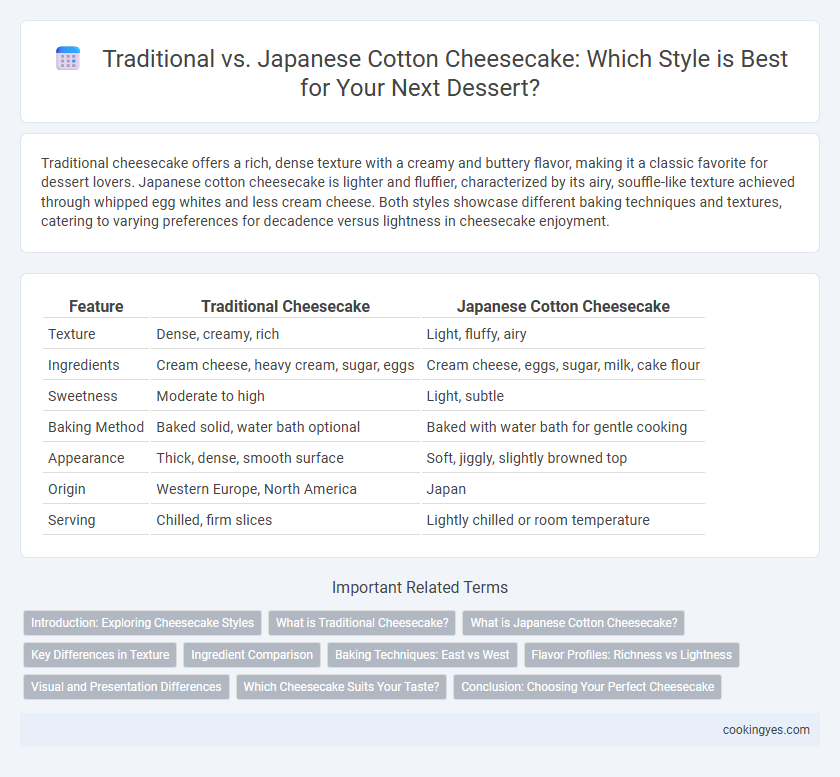Traditional cheesecake offers a rich, dense texture with a creamy and buttery flavor, making it a classic favorite for dessert lovers. Japanese cotton cheesecake is lighter and fluffier, characterized by its airy, souffle-like texture achieved through whipped egg whites and less cream cheese. Both styles showcase different baking techniques and textures, catering to varying preferences for decadence versus lightness in cheesecake enjoyment.
Table of Comparison
| Feature | Traditional Cheesecake | Japanese Cotton Cheesecake |
|---|---|---|
| Texture | Dense, creamy, rich | Light, fluffy, airy |
| Ingredients | Cream cheese, heavy cream, sugar, eggs | Cream cheese, eggs, sugar, milk, cake flour |
| Sweetness | Moderate to high | Light, subtle |
| Baking Method | Baked solid, water bath optional | Baked with water bath for gentle cooking |
| Appearance | Thick, dense, smooth surface | Soft, jiggly, slightly browned top |
| Origin | Western Europe, North America | Japan |
| Serving | Chilled, firm slices | Lightly chilled or room temperature |
Introduction: Exploring Cheesecake Styles
Traditional cheesecake features a dense, creamy texture primarily made with cream cheese, eggs, and a graham cracker crust, offering a rich and indulgent experience. Japanese cotton cheesecake, known for its light, airy, and souffle-like consistency, utilizes whipped egg whites and a blend of cream cheese and milk, resulting in a fluffy texture with a subtle sweetness. Both styles showcase distinctive techniques and ingredients that cater to different preferences in cheesecake density and flavor profiles.
What is Traditional Cheesecake?
Traditional cheesecake features a dense, creamy texture made from cream cheese, eggs, sugar, and a graham cracker or biscuit crust, often baked to achieve a rich and firm consistency. This style originated in New York and is characterized by its heavy, custard-like structure and pronounced tanginess from cream cheese. Unlike Japanese cotton cheesecake, which is lighter and fluffier due to whipped egg whites, traditional cheesecake emphasizes decadence and a smooth, velvety finish.
What is Japanese Cotton Cheesecake?
Japanese cotton cheesecake is a light, airy dessert characterized by its soft, fluffy texture achieved through the incorporation of whipped egg whites, differentiating it from traditional dense, creamy cheesecakes made with cream cheese and a heavier base. This style originated in Japan and combines techniques from souffle and sponge cake baking, resulting in a low-fat, less sweet alternative that melts in the mouth. The unique texture is due to a double-baking method and the gentle folding of meringue into the cream cheese mixture, creating a delicate, cotton-like consistency.
Key Differences in Texture
Traditional cheesecake features a dense, creamy texture achieved through a rich cream cheese base, while Japanese cotton cheesecake is renowned for its airy, souffle-like lightness created by folding whipped egg whites into the batter. The higher egg content and lower fat ratio in Japanese cotton cheesecake result in a delicate, jiggly texture that melts in the mouth. In contrast, the traditional style offers a firmer bite with a smooth, velvety consistency perfect for a richer dessert experience.
Ingredient Comparison
Traditional cheesecake relies heavily on cream cheese, sugar, eggs, and a graham cracker crust, resulting in a dense and rich texture packed with a pronounced tangy flavor. Japanese cotton cheesecake uses cream cheese, milk, eggs, and a significant amount of egg whites whipped into a meringue, creating a light, airy, and fluffy consistency with a subtle sweetness. The ingredient differences lead to traditional cheesecake being heavier and creamier, while Japanese cotton cheesecake exhibits a spongy texture and less intense flavor profile.
Baking Techniques: East vs West
Traditional Western cheesecake relies on dense, creamy textures achieved through baking with a water bath to ensure gentle, even heat and prevent cracking. Japanese cotton cheesecake uses a souffle-like technique, incorporating whipped egg whites to create a light, airy texture with a moist, fluffy crumb. The East emphasizes precise folding and lower baking temperatures for softness, while the West focuses on richness and firmness through longer baking times and heavier ingredients.
Flavor Profiles: Richness vs Lightness
Traditional cheesecake offers a rich and creamy flavor profile with dense texture, highlighting the full-bodied taste of cream cheese and butter. Japanese cotton cheesecake delivers a lighter, airy experience with subtle sweetness and delicate tang from whipped egg whites, creating a melt-in-the-mouth softness. The contrast in flavor richness and texture defines the choice between indulgent traditional and fluffy Japanese cotton cheesecake styles.
Visual and Presentation Differences
Traditional cheesecake features a dense, creamy texture with a rich golden-brown top and firm edges, creating a classic, polished appearance ideal for elegant dessert presentations. Japanese cotton cheesecake boasts a lighter, fluffier texture with a pale, almost snow-white surface and a soft, jiggly consistency that adds a delicate, visually airy charm perfect for minimalist plating. The contrasting visual elements highlight the traditional version's robustness against the Japanese style's ethereal, cloud-like aesthetic, influencing their appeal in different culinary settings.
Which Cheesecake Suits Your Taste?
Traditional cheesecake features a dense, creamy texture with a rich flavor, appealing to those who enjoy a classic, indulgent dessert experience. Japanese cotton cheesecake offers a lighter, fluffier consistency with a subtle sweetness, perfect for people who prefer a delicate and airy treat. Choosing between them depends on whether you favor a rich, velvety bite or a soft, melt-in-your-mouth sensation.
Conclusion: Choosing Your Perfect Cheesecake
Traditional cheesecake offers a dense, creamy texture with rich flavors stemming from cream cheese and a classic graham cracker crust, ideal for those who prefer indulgent desserts. Japanese cotton cheesecake features a lighter, airy consistency achieved through whipped egg whites and less cream cheese, appealing to fans of delicate, fluffy sweets. Selecting the perfect cheesecake depends on whether you desire a rich, substantial bite or a soft, cloud-like experience, aligning with personal taste preferences and dessert occasions.
Traditional vs Japanese cotton for cheesecake style Infographic

 cookingyes.com
cookingyes.com